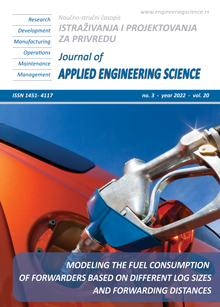PERFORMANCE OF A HEAT PIPE SOLAR COLLECTOR WITH EVACUATEDPOLYCARBONATE FRONT COVER
Abstract
In this research, the effect of vacuum on the thermal efficiency of a heat pipe solar collector is investigated. A comparative study of solar energy loss through different transparent covering materials, including different thicknesses of clear Polycarbonate (PC) and glass sheets, is performed to choose the best covering material. The results of solar energy loss tests show that for a 4mm, and 6mm thickness covering materials, transparent PC sheets have 11% and 22% less solar energy loss respectively than glass sheets. Three cases of flat heat pipe solar collector with different covering designs that are: no cover, non-vacuumed, and vacuumed double layer PC sheets are tested. Results show that the combination of a 4mm high transmittance PC cover with vacuumed spacing results in an overall collector thermal efficiency of about 70% in comparison with only 57% for non-vacuumed double layer PC cover.
References
International Energy Agency (IEA). Renewables 2020, Analysis and forecast to 2025. (2020). An online report. Retrieved from: https://www.iea.org/reports/renewables-2020/renewable-heat>
Eurostat Statistics explained (2020) Energy consumption in households. Accessed June 21 2020. Retrieved from: https://ec.europa.eu/eurostat/statistics-explained/index.php?title=Energy_consumption_in_households>
Budihardjo, I., & Morrison, G. L. (2009). Performance of water-in-glass evacuated tube solar water heaters. Solar Energy, 83(1), 49-56.https://doi.org/10.1016/j.solener.2008.06.010>
Kessentini, H., Castro, J., Capdevila, R., & Oliva, A. (2014). Development of flat plate collector with plastic transparent insulation and low-cost overheating protection system. Applied Energy, 133, 206–223. doi: 10.1016/j.apenergy.2014.07.093
Liang, J., Ji, X., Han, J., & Wang, Y. (2020). Modeling and experimental investigation on a direct steam generation solar collector with flat plate thermal concentration. Energy Exploration & Exploitation, 38(5), 1879-1892.https://doi.org/10.1177/0144598720922681
Papadimitratos, A., Sobhansarbandi, S., Pozdin, V., Zakhidov, A., &Hassanipour, F. (2016). Evacuated tube solar collectors integrated with phase change materials. Solar Energy, 129, 10-19. https://doi.org/10.1016/j.solener.2015.12.040
Abd-Elhady, M. S., Nasreldin, M., &Elsheikh, M. N. (2018). Improving the performance of evacuated tube heat pipe collectors using oil and foamed metals. Ain Shams Engineering Journal, 9(4), 2683-2689. https://doi.org/10.1016/j.asej.2017.10.001>
Kiliç, F., Menlik, T., &Sözen, A. (2018). Effect of titanium dioxide/water nanofluid use on thermal performance of the flat plate solar collector. Solar Energy, 164, 101-108.https://doi.org/10.1016/j.solener.2018.02.002>
Sarafraz, M. M.; Tlili, Iskander; Abdul Baseer, Mohammad; Safaei, Mohammad R. (2019). "Potential of Solar Collectors for Clean Thermal Energy Production in Smart Cities using Nanofluids: Experimental Assessment and Efficiency Improvement" Appl. Sci. 9, no. 9: 1877. https://doi.org/10.3390/app9091877>
Azad, E. (2008). Theoretical and experimental investigation of heat pipe solar collector. Experimental Thermal and Fluid Science, 32(8), 1666-1672. https://doi.org/10.1016/j.expthermflusci.2008.05.011>
Liang, R., Ma, L., Zhang, J., & Zhao, D. (2011). Theoretical and experimental investigation of the filled-type evacuated tube solar collector with U tube. Solar Energy, 85(9), 1735–1744. https://doi.org/10.1016/j.solener.2011.04.012>
Shemelin, V., &Matuska, T. (2017). Detailed Modeling of Flat Plate Solar Collector with Vacuum Glazing. International Journal of Photoenergy, 2017, 1–9. https://doi.org/10.1155/2017/1587592>
Arya, Farid, Hyde, Trevor, Henshall, Paul, Eames, Philip C., Moss, Roger W. and Shire, G. S. F. (2016) Current developments in flat-plate vacuum solar thermal collectors. International Scholarly and Scientific Research & Innovation, 10 (6). pp. 688-692.http://waset.org/publications/10004587/>
Giovannetti, F., Föste, S., Ehrmann, N., &Rockendorf, G. (2014). High transmittance, low emissivity glass covers for flat plate collectors: Applications and performance. Solar Energy, 104, 52–59. DOI: 10.1016/j.solener.2013.10.006
Bozkurt, I., Atiz, A., Karakilcik, M. Dincer, I. (2013). Investigation of Effect of Transparent Covers on Performance of Cylindrical Solar Ponds, International Journal of Green Energy, DOI: 10.1080/15435075.2013.773900
Kalidasan, B., & Srinivas, T. (2014). Study on effect of number of transparent covers and refractive index on performance of solar water heater. Journal of Renewable Energy, 2014.https://doi.org/10.1155/2014/757618>
Li, Z., Chen, C., Luo, H., Zhang, Y., &Xue, Y. (2010). All-glass vacuum tube collector heat transfer model used in forced-circulation solar water heating system. Solar Energy, 84(8), 1413–1421. DOI: 10.1016/j.solener.2010.05.001
Kern, J., & Harris, I. (1975). On the optimum tilt of a solar collector. Solar Energy, 17(2), 97–102. DOI:10.1016/0038-092x(75)90064-x
Demain, C., Journée, M., & Bertrand, C. (2013). Evaluation of different models to estimate the global solar radiation on inclined surfaces. Renewable Energy, 50, 710–721. DOI: 10.1016/j.renene.2012.07.031
Yousefi, T., Veysi, F., Shojaeizadeh, E., &Zinadini, S. (2012). An experimental investigation on the effect of Al2O3–H2O nanofluid on the efficiency of flat-plate solar collectors. Renewable Energy, 39(1), 293-298. ttps://doi.org/10.1016/j.renene.2011.08.056
Hollman, J.P. (2012), Experimental methods for engineers. 8th.Edition. McGraw-Hill company.

